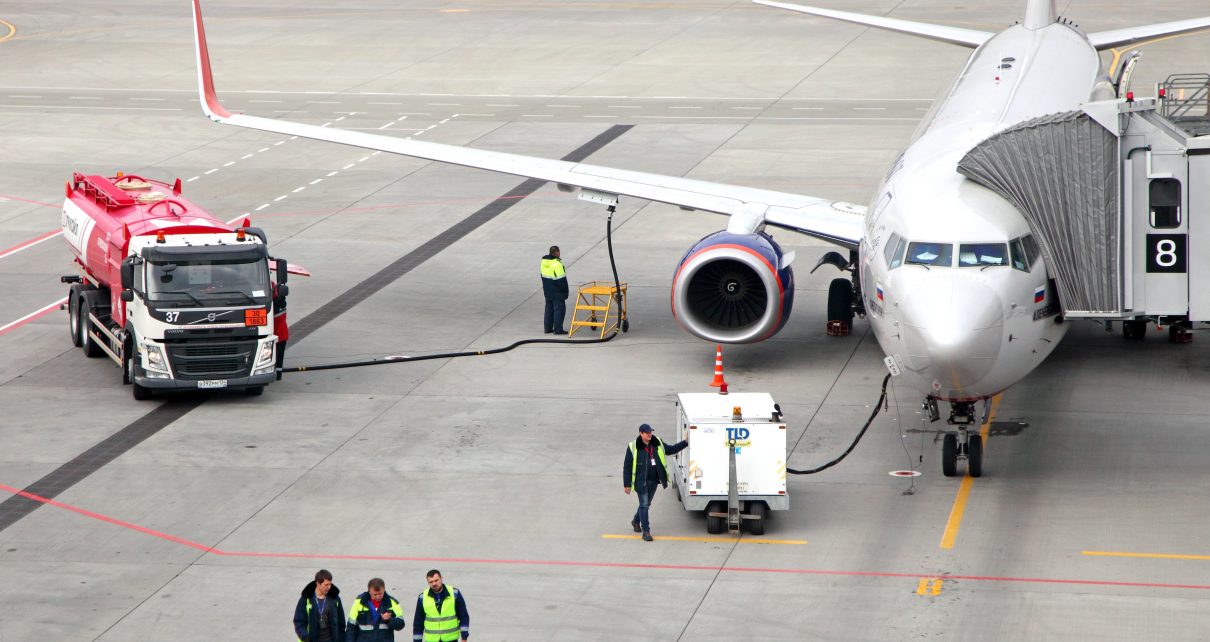The Department of Energy is taking a fresh look at a tough research problem that has baffled experts for more than a decade: developing a low-cost alternative to jet fuel.
The search began around 2010, initially pushed by the Department of Defense’s concerns about the United States’ reliance on imported oil. More recently, airlines have raised the question themselves. They’re facing potential restrictions on carbon dioxide emissions from jet airliners and the lack of a near-term, electricity-fueled replacement for their heavy planes.
Among the more daunting aspects of the search for a feedstock to replace jet fuel is that there has to be plenty of it. The aviation industry uses as much as 1.7 billion barrels of jet fuel in a year. Any alternative to fossil fuels has to be cheap. Fuel is the airline industry’s largest operating cost.
Researchers at DOE’s National Renewable Energy Laboratory (NREL) are taking a fresh look at a promising family of new and plentiful feedstocks: animal wastes, food wastes and urban sewage sludge containing human manure.
“Everyone is beginning to see the potential of taking these organic materials that we normally have sent to landfills or wastewater treatment facilities,” said Derek Vardon, a senior research engineer at NREL who is working on the problem along with other DOE laboratories and outside companies.
Their overall goal is to short-circuit the normal processes of decay that occur in landfills or in, say, a cow’s stomach that breaks down biomass. That process usually results in methane—the major component of natural gas and a significant global warmer.
Some of the researchers will experiment with catalysts to chemically alter the biological process so its end product is not methane, but a more potent liquid fuel and one that produces only about 50% of the CO2 emissions that jet fuel produces when it is burned.
Manure and food wastes contain carboxylic acids, a family of fatty acids that can be altered through the catalytic process to link their chain-like structures together. The results are a liquid fuel, Vardon explained, one that has as much as seven times the energy of methane. That’s needed to get a heavy airliner off the ground.
“We’ve been working on developing technology that is industrially relevant, and we have industry advisers who are the heart and soul of this project,” Vardon said in an interview. He noted that Southwest Airlines Co. and Boeing Co. are among those involved.
Research will begin with experiments using food wastes and work on scaling up to an initial facility that can make at least a thousand gallons of fuel. The next step would be assessing its reliability as a power source for test flights.
“Some of these advances are going to happen because you need high-energy-density forces for flight, and air travel is an integral part of our society,” said Vardon, admitting that it will “take more rigor to scale the process up.”
The idea is that human feces and food wastes may be the vital ingredients for this research, which has over the years focused on efforts to make jet fuel out of alcohols, sugar, palm seeds, soybeans, corn, wood chips and coal.
That may seem shocking to some people, but other researchers are also sensing the potential of rich and low-carbon resources that could be developed in alliances with sewage treatment plants.
One of them is Jianping Yu, the main investigator of a separate NREL project that is exploring how to remove phosphorus and nitrogen, major and troublesome water pollutants, from conventional sewage treatment processes.
His idea is to feed the pollutants to algae in the sewage plants and then sell the algae as a product that can be made into commercial fertilizers. Algae can also be made into polymers that can be used to make a variety of materials, Yu explained, including shoes and backpacks.
What aroused his curiosity about algae was that some strains consume considerably more phosphorus than others. They store it in their bodies for later use. He calls it a “luxury uptake” because they don’t need it to survive.
Then he learned about a company called Gross-Wen Technologies Inc. It was established by two Iowa State University professors, who had developed and patented a cheaper way to recover nitrogen and phosphorus from wastewater using algae.
Yu’s idea is to collect and develop strains of super-eaters among the algae, so they can remove as much as 50% more of the pollutants from processed wastewater.
Growing more powerful algae, he points out, will also be a way for the plants to remove more CO2 from the air. The other ingredient that they will need is sunlight, which is also free.
The upshot is that it could reduce the amount of energy needed to run sewage treatment plants. “That’s the goal. Our main motivation is future environmental requirements,” Yu said.
Needless to say, the goal is very appealing to some of NREL’s partners in this project, including the Metropolitan Water Reclamation District of Greater Chicago, which is responsible for wastewater and stormwater management in Cook County, Ill.
“It’s hard to overstate how exciting this is,” exclaimed Debra Shore, a commissioner of the district, which is adapting its system to include the enhanced algae-producing process.
Reprinted from Climatewire with permission from E&E News. E&E provides daily coverage of essential energy and environmental news at www.eenews.net.




